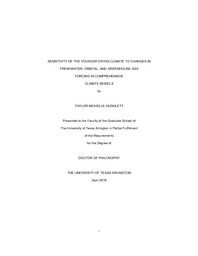
ATTENTION: The works hosted here are being migrated to a new repository that will consolidate resources, improve discoverability, and better show UTA's research impact on the global community. We will update authors as the migration progresses. Please see MavMatrix for more information.
Show simple item record
| dc.contributor.advisor | Winguth, Arne M. E. | |
| dc.creator | Hughlett, Taylor Michelle | |
| dc.date.accessioned | 2016-09-28T18:16:46Z | |
| dc.date.available | 2016-09-28T18:16:46Z | |
| dc.date.created | 2016-05 | |
| dc.date.issued | 2016-05-11 | |
| dc.date.submitted | May 2016 | |
| dc.identifier.uri | http://hdl.handle.net/10106/25906 | |
| dc.description.abstract | The Younger Dryas cooling event (~12,900 years before present) was the most recent abrupt climate change in the geologic record where climate for the Northern Hemisphere returned to a near-glacial state. The cause of this cooling event is widely controversial, and no consensus has been found as to why the onset of the cooling occurred. Of the several hypotheses proposed, the freshening of the North Atlantic Ocean due to meltwater discharge from the retreating Lake Agassiz and subsequent changes in oceanic circulation is the most widely accepted one. Additionally, this abrupt climate change can be attributed to other changes in the forcing boundary conditions, for example changes in orbital forcing, and changes in greenhouse gas concentrations in the atmosphere.
In this study, each of these three potential triggers of rapid climate change was explored by using comprehensive climate models. The Atlantic meridional overturning circulation (AMOC) is slightly more sensitive to the Mackenzie River discharge (a 9 Sv circulation decrease) as opposed to St. Lawrence discharge (a 7 Sv circulation decrease). High-resolution simulations separating the same magnitude of discharge from both locations are needed to evaluate the impact of distinct regional fresh water forcing. The AMOC reduction by freshwater forcing into the Northern Atlantic Ocean during the Younger Dryas causes a decrease in surface air temperature in agreement with surface air temperature reconstructions from Greenland. The climatic effect of freshwater forcing and the effect of the ice sheet during the Younger Dryas exceed the effects of both the greenhouse gas and orbital forcing. The Younger Dryas climate is more greatly affected by changes in orbital forcing than by changes in greenhouse gas concentration due to the fact that changes in radiative forcing from orbital parameters are stronger than the change due to greenhouse gas forcing. However, the effects of orbital and CO2 forcing alone are not enough to cause a transition into a Younger Dryas climate state, indicating that freshwater forcing is required.
The intensity of the West African monsoon is more substantially affected by changes in the orbital parameters compared to changes in the atmospheric pCO2 values. The model simulations suggest that the West African monsoon during the Younger Dryas was colder and drier, which is related to climatic changes in the North Atlantic region. These findings agree with analyses of proxy reconstructions. Thus the freshwater forcing and the ice sheet may be important to the decline in West African monsoon circulation during the Younger Dryas. A simulated southward shift in the ITCZ due to the Northern hemispheric cooling is also in agreement with previous studies. | |
| dc.format.mimetype | application/pdf | |
| dc.language.iso | en_US | |
| dc.subject | Younger Dryas | |
| dc.subject | Freshwater | |
| dc.subject | Orbital | |
| dc.subject | Greenhouse gas | |
| dc.subject | Paleoclimate | |
| dc.subject | Paleoceanography | |
| dc.subject | Climate modeling | |
| dc.subject | CESM | |
| dc.subject | CCSM | |
| dc.subject | Monsoon | |
| dc.title | Sensitivity of the Younger Dryas climate to changes in freshwater, orbital, and greenhouse gas forcing in comprehensive climate models | |
| dc.type | Thesis | |
| dc.degree.department | Earth and Environmental Sciences | |
| dc.degree.name | Doctor of Philosophy in Earth and Environmental Science | |
| dc.date.updated | 2016-09-28T18:16:47Z | |
| thesis.degree.department | Earth and Environmental Sciences | |
| thesis.degree.grantor | The University of Texas at Arlington | |
| thesis.degree.level | Doctoral | |
| thesis.degree.name | Doctor of Philosophy in Earth and Environmental Science | |
| dc.type.material | text | |
| dc.creator.orcid | 0000-0002-7973-954X | |
Files in this item
- Name:
- HUGHLETT-DISSERTATION-2016.pdf
- Size:
- 116.0Mb
- Format:
- PDF
This item appears in the following Collection(s)
Show simple item record


